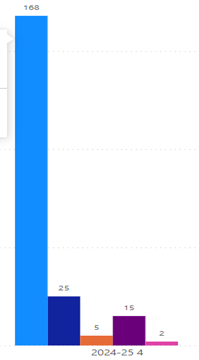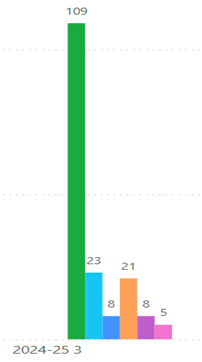06 Jun 2025
#COUNCIL NEWS
Issue 53 - June 2025
** This issue:
------------------------------------------------------------
1. New Consenting System
2. The Importance of Getting It Right
3. Details for approval
4. Inspections
5. Storm Water Solutions
6. Fees and Charges
7. Consent Stats
New Consenting System - Objective BUILD
------------------------------------------------------------
As many of you will know by now, we are in the process of implementation and testing of the new consenting software and working through all that technical stuff. We are confident that once we are up and running, notwithstanding the inevitable teething problems, we will have a superior consenting product for both applicant and BCA.
As mentioned in the previous edition, the fee structure associated with this new consenting system, in line with council direction, is based on a user pay model. Therefore, the fees associated with using the system are broken down as follows:
* Applications with work valued up $125,000, will be a flat rate of $80.00
* Applications with work valued over $125,000 will be calculated by a percentage multiplier of 0.075%.
Calculation example: Building work value $600,000 x 0.075% = $450 (excl GST)
The percentage multiplier is capped at the value of $2,500,00.00 resulting in a max fee of $1,875.00.
The percentage multiplier, based on the value of work, reflects the usage of the system related to the complexity of the project, ie, greater the value - greater the complexity - greater the usage of the system (flow of information).
It is important to remember that all other applicable building consent fees and charges still apply, with this software fee being attributed to the user of the system rather than the rate payers of the district.
As we get closer to the GoLive date, approx mid July 2025, we would like to know if you (the users) would like a demo of how the new system operates/work for you as the applicant. So please email me Jayson.ellis@timdc.govt.nz (mailto:Jayson.ellis@timdc.govt.nz) if you believe this would be of use to you and we will look at putting together a workshop towards the end of June or early July.
The Importance of Getting it Right
We all know the old adage “Get it right first time”. This can also be attributed to the consenting process and any approval process within council. One thing we have consistently found when there are multiple council approvals required for the one project e.g Resource, Building and Service consents, is that the plans for the respective approval types all vary or are inconsistent with each other.
Therefore, what would be very helpful and provide efficiency to the approval process, is that where possible, ensure that the same plans relating to the project are utilised for the varying approvals. This will help with consistency in the design and the efficiency of approvals.
Council appreciates the frustration in having to submit information for multiple applications. Wouldn’t it be great if you could just submit one set of documentation for multiple approval types, but unfortunately that option doesn’t exist (for many reasons) so, we all need to work with the many regulations as best we can to achieve as much efficiency within the process as possible.
Details for Approval
As technology develops and evolves and now having a wealth of information online, there have been occasions where applicants have made reference to websites and digital links within their application for the BCA to refer to. Whilst in theory that sounds logical, the ability for the BCA to approve (stamp with the consent number) a website or a link to a web page is impossible to achieve. Therefore, as the consenting system currently requires, please remember that the information you submit as part of your application must be actual documentation so it can be approved.
** Stormwater Solutions
------------------------------------------------------------
Many in the local construction industry will be aware of Timaru District Council’s (TDC) Acceptable Solution #1 for above ground stormwater attenuation tanks that are to be established when additional hardstand, impervious surfaces are constructed on a site. Accordingly, TDC has developed a second acceptable solution to standardize soakage device design and dimensions to be utilized in our stormwater management areas with more permeable ground conditions (Pleasant Point, Temuka and Geraldine).
The primary goals of Acceptable Solution #2 is to simplify the process for determining dimensions of the soakage device and identify a design that allows for regular inspection and maintenance.
Standardized Dimensions
In circumstances where a TDC piped stormwater network is not present or available to be connected to, the Canterbury Land and Water Regional Plan (LWRP) rule 5.96 applies. This rule sets out the permitted conditions for discharges of stormwater to land where contaminants may enter groundwater. The conditions include the following requirements for the design of the stormwater disposal system to ground:
1. The discharge is not from, into or onto contaminated or potentially contaminated land; and
2. The discharge:
(a) does not cause stormwater from up to and including a 24 hour duration 10% Annual Exceedance Probability rainfall event to enter any other property; and
(b) does not result in the ponding of stormwater on the ground for more than 48 hours, unless the pond is part of the stormwater treatment system; and
(c) is located at least 1 m above the seasonal high water table that can be reasonably inferred for the site at the time the discharge system is constructed; and
(d) is only from land used for residential, educational or rural activities; and
(e) does not occur where there is an available reticulated stormwater system, except where incidental to a discharge to that system; and
(f) is not from a system that collects and discharges stormwater from more than five sites.
Using the above design requirements set out by the LWRP along with the sizing calculations and procedure from the Building Code E1: Surface Water (E1), standard soakage device dimensions have been determined for multiple bands of additional impervious site coverage from 30-250m2 and where impervious surfaces are less than 70% of total site coverage.
Standardised Design
Stormwater management systems are notorious for being neglected, until the big deluge occurs and all of a sudden our private properties, roads, etc. are subject to nuisance ponding. This can often be mitigated through regular inspection and maintenance of our drainage devices and systems. Most designers, builders and drainage trades will be aware of the Rock Soak Pit and Chamber Soak Pit solutions in Figure 13 of E1. These two solutions are limited in their ability to achieve building code clause E1.3.3(d).
E1.3.3 says,
Drainage systems for the disposal of surface water shall be constructed to:
(d) Provide reasonable access for maintenance and clearing blockages.
The standard design to be installed for Acceptable Solution #2, supplies clear access to the chamber receiving the discharge from the impervious site coverage. This access chamber allows for easy inspection to identify blockages and the need for any necessary maintenance.
For more information on Acceptable Solution #2 or if you have any comments on the standard dimensions and design, please contact the TDC Stormwater Team at stormwater@timdc.govt.nz.
Fees and Charges increasing from 1 Jul
------------------------------------------------------------
Just a heads up for the new financial year starting 1 July 2025, council has indicated that Building fees and charges will be increasing by approximately 10%. This is not yet confirmed, as this will only be adopted at the end of June. Once ratified by council I will forward a copy of the new fees and charges to you all.
------------------------------------------------------------
Consent statistics 3rd quarter for financial year 2024-2025
------------------------------------------------------------
Applications Received (Jan - March 2025)
Applications Granted (Jan - March 2025)
Inspections Undertaken (Jan - March 2025)

Code Compliance Certificates (CCC) Issued (Jan - March 2025)

Categories:
